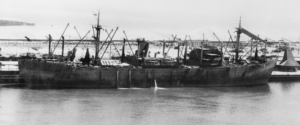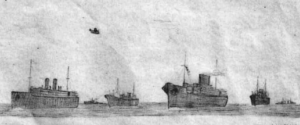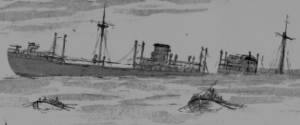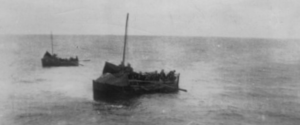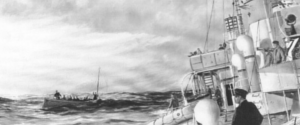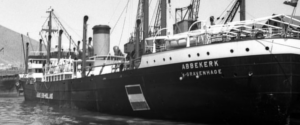Colombo: (not so) inconspicuous arrival

16th of April. Abbekerk approaches Ceylon with her crew knowing from overheard radio signals that the Japanese have wreaked havoc and that it is not unlikely there are still enemy forces in the area. Everybody is on full alert. A few days before reaching Colombo a dot appears on the horizon and soon they can see a plane approaching. It’s directly ahead and it’s impossible to see whether it’s British or Japanese. But protocol dictates a British plane to circle widely around the ship so that their marking can be seen or fire a flare. It does neither.
We could see that it was almost certain a Swordfish bi-plane. An English torpedo bomber we knew that it was slow. But the Japs had captured numerous planes so we could not be certain it really was British. It keep fly straight at us. So at a certain moment we opened fire and the plane turned away.
Third mate Jacob Visser.
Everyone had the same thought: ‘Let’s down with that plane!’. When indeed the machine was coming so close that it was within firing range the Captain ordered the crew to fire. The trigger-happy gunners did not wait for a second command and fired away. After using up two tins of ammo, the plane turned around and disappeared out of sight, not before we had all noticed that it had British markings!! The fact that the aircraft was still flying did not say much for our ability as gunners.
Ass. engineer Adriaan Kik
I remember a small aircraft approaching our ship and the crew firing at it with streams of tracer bullets which could be seen missing the plane which turned away and disappeared I was told afterwards that the plane was British and did not give us a signal which it should have done.
Nigel Wooldridge, 10 y/o passenger
The plane, despite its slow speed and straightforward approach, seemed not hit. That’s not surprising giving the fact that Abbekerk is not a warship and its crew not highly trained. And besides that the two Lewis machine guns and two Oerlikons can hardly be called a serious defence. They also have a limited free line of fire because of the superstructure, masts and rigging. During an earlier attack, south of Tjilatjap, the ship was hit by its own fire, that doesn’t seem to have happened now.
With the plane disappearing, tranquillity returns.
The quiet after the shooting was so intense that we very clearly heard the voice of the lookout in the crowsnest, who in no uncertain and not very complimentary terms swore at the crowd on the bridge that they all had nearly killed him during the shootout at the aircraft. He was immediately ordered to come down which was not easy because he was shaking like a leaf. When he finally arrived on the bridge the captain apologized, gave him a bottle of Dutch Gin and told him to go ‘home’ and take the day off.
Ass. engineer Adriaan Kik
A day and a half later in the middle of the night Abbekerk reaches the port of Colombo and disaster almost happens. To shield the port from submarines and torpedoes, anti torpedo nets hanging from floats were placed in front of the entrance. When ships enter the port the net are partially opened. But apparently Abbekerk misses the opening.
When we entered Colombo harbour at night, we apparently hit the anti submarine nets and I saw flares come up out of the water. These were to illuminate us so that the shore batteries could shell us if we were enemy. Fortunately they did not open fire.
Nigel Wooldridge, 10 y/o passenger

